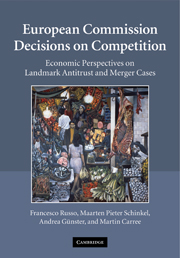 European Commission Decisions on Competition
European Commission Decisions on Competition Book contents
- Frontmatter
- Contents
- List of figures
- List of tables
- List of abbreviations
- Table of legislation
- Table of equivalences
- Acknowledgments
- 1 Introduction
- 2 Horizontal restrictions
- 3 Abuse of dominance
- 4 Licensing
- 5 Vertical restrictions
- 6 Joint ventures and alliances
- 7 Restrictions to competition by Member States
- 8 Mergers and acquisitions
- Annex I Decisions related to procedural issues
- Annex II Table of landmark decisions described in the book
- Annex III Table of mergers blocked by the European Commission in chronological order
- Annex IV Table of landmark merger decisions described in the book in alphabetical order
- Annex V Table of antitrust decisions in alphabetical order
- Bibliography
- Index
4 - Licensing
Published online by Cambridge University Press: 04 August 2010
- Frontmatter
- Contents
- List of figures
- List of tables
- List of abbreviations
- Table of legislation
- Table of equivalences
- Acknowledgments
- 1 Introduction
- 2 Horizontal restrictions
- 3 Abuse of dominance
- 4 Licensing
- 5 Vertical restrictions
- 6 Joint ventures and alliances
- 7 Restrictions to competition by Member States
- 8 Mergers and acquisitions
- Annex I Decisions related to procedural issues
- Annex II Table of landmark decisions described in the book
- Annex III Table of mergers blocked by the European Commission in chronological order
- Annex IV Table of landmark merger decisions described in the book in alphabetical order
- Annex V Table of antitrust decisions in alphabetical order
- Bibliography
- Index
Summary
Introduction
A license is a legal instrument through which the owner of an intellectual property right (IPR) confers upon another party the right to (temporarily) use its IPR. Licenses are one of several ways to arrange exploitation of an IPR, together with direct exploitation and assignment. The licensing of IPRs is a valuable instrument to both stimulate and disseminate innovation and new technologies. The license mechanism can increase competition by allowing new entrants equal access to high technological standards. Licenses are accordingly generally seen as an expression of dynamic and innovative economies.
In certain circumstances, however, competition concerns related to licensing may arise. In most cases, licensing agreements provide the licensee with a conditional permission to exploit the right in question. Frequently, these concern the protection of confidential information, the meeting of high quality standards in the production or the use of the licensed good, or a protection against the risk of competition from the licensee. These conditions and obligations attached to the agreement can have anticompetitive intent and/or effect. Licensors can, for example, eliminate the possibility that the licensee will compete in one or more of its markets. It can do so by limiting the scope of application or confine territorial application of the IPR. Licensing conditions also often include explicit non-competition clauses or limitations on the licensee's freedom to deal with the licensor's competitors.
- Type
- Chapter
- Information
- European Commission Decisions on CompetitionEconomic Perspectives on Landmark Antitrust and Merger Cases, pp. 198 - 217Publisher: Cambridge University PressPrint publication year: 2010


